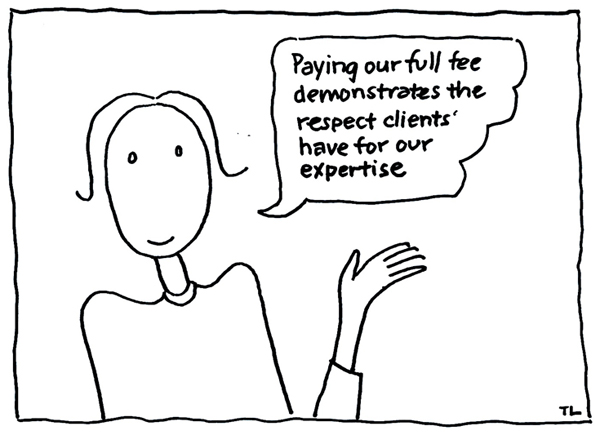
Step 1: Create a Virtuous Cycle
By definition, a Virtuous Cycle is a series of events that result in a favorable outcome, time and again. For creative professionals it means using your work, and the insights gained from to attract the attention of future clients.
The prospect’s interest means that they have accepted you as an expert and when that occurs, fees become ‘non-negotiable’.However, if you do respond to pressure to reduce fees you will loose some of your negotiating power in the relationship.
A well-managed Virtuous Cycle negates the need to negotiate.
Step 2: Behave like an expert
Experts:
– Determine how to meet client needs.
– Ask questions and create plans.
– Develop lists of deliverables required to achieve success.
– Develop a budget to create the agreed scope of work.
– Do not cut fees to appease client demands. Cutting fees undermines the potential for success.
Step 3: Do not accept the initial offer
Always assume there is a larger budget available. Clients who present an initial budget expect you to ask for more and if you do not they will loose some respect for you. To maintain your expert position, define the scope required to meet the client’s need. That means you determine the budget, too.
Step 4: Ask questions, listen to their answers
Listening is a powerful tool. Listen, take notes, read back what you wrote and ask for clarification. You will learn what the client really wants, needs and how it will shape the future of the company. The more you learn, the more precisely you’ll be able to define your response.
Step 5: Avoid talking too much
Talking too much is a sign of discomfort and neediness. Do not do it. It is interpreted as a sign of nervous tension and insecurity at the bargaining table.
Step 6: Do not give the client anything for free
If you do not value your work, clients will not either. Always get something in return for everything you provide to the client. In our market economy, everything of value is measured by money. If you do not ask for an appropriate fee, the client will not value the work.
Step 7: Separate your services from yourself
When you’re at the bargaining table, train yourself to care, but not too much. When we care too much we loose perspective and sometimes our insecurities, rise to the surface. If that happens you must find an excuse to leave the bargaining table. (I know this is difficult for creative people; we are the product, as a result it is difficult to not care too much.)
Step 8: Never cut deliverables to meet the client’s budget
Cutting deliverables completely undermines your expert status. You have built the exact combination of deliverables to provide the best possible solution If, under the pressure of bargaining, you cut them it says you are, just like everyone else, desperate for the work. Cutting deliverables is epidemic in creative services. Do not do it.
Step 9: Never rush to close
Recognize the negotiating stage as part of the creative process. Take the time you need to understand every step, every detail of the process. Be guided by the phrase, “I have all the time in the world.” Rushing to close is a classic sign of insecurity. (Often we are so uncomfortable negotiating that we just want to get through bargaining so we can do the work. No surprise, the work is our first love.)
Step 10: Do not reveal your bottom line
Often, in a misguided attempt to connect personally with the client, you feel the need to reveal more than is required. You never want the client to know how you compiled your costs or what your real bottom line is. Rest assured, the client will use it against you. Or worse, they will feel taken advantage of if they paid more than your bottom line.
Creative professionals have the power to improve the world. Unfortunately, they often do not get paid what they deserve for their services. My mission is to change that.